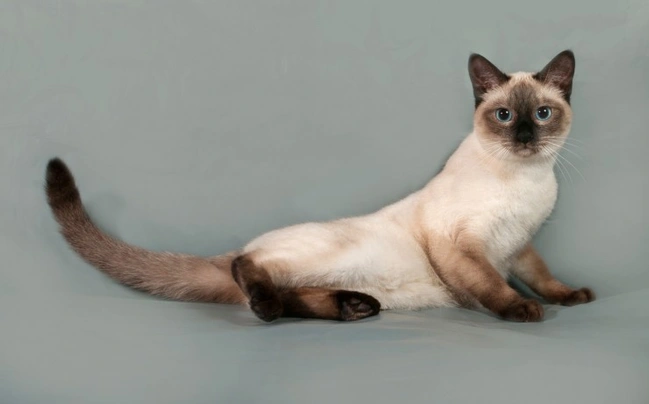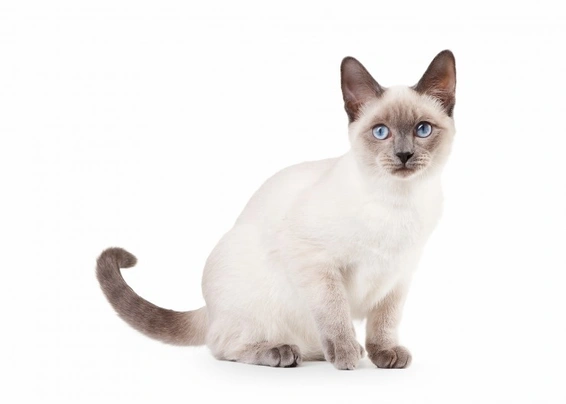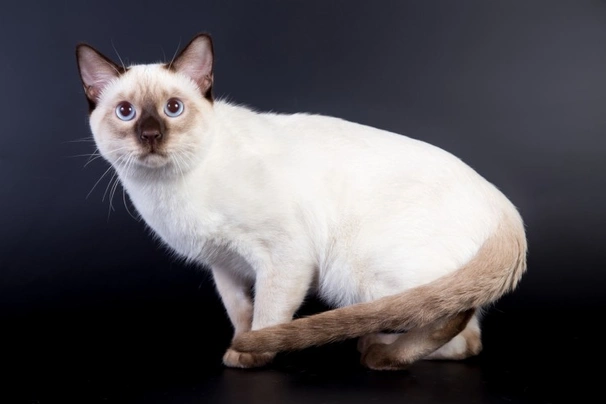Thai
Introduction of the Thai
Thai cats resemble the Korat because they are their self-coloured cousins. They come in two types being the Thai Lilac and the Thai Blue Point. They are recognised as a breed in their own right by the GCCF and over the years these charming cats have earned themselves the reputation for being wonderful companions and family pets. Thai cats have a ton of personality which when paired to their lovely looks means sharing a home with one is always extremely entertaining and a real pleasure.
History of the Thai
Since Korats were bred in the West in the late fifties breeders found that some kittens were born with Siamese colours and shading with blue being restricted just to a cat's face ears legs paws and their tails. In many countries of the world these kittens were considered as being Korats but not true to type. In 1989 breeders mated two Korats and they produced a kitten with a pink coat. Then in the early nineties more kittens were born in other Korat litters that boasted having white and pink coats.
Pretty soon breeders realised that recessive genes were responsible for the new "colours" and that these genes had been dormant in Korats over many generations. However when they emerged kittens were born with diluted coat colours or restricted coat colours which resulted in the Thai Lilac and the Thai Blue Point being born.
Today Thai cats are becoming more popular thanks to their charming looks and kind playful affectionate natures although anyone wishing to share a home with one would need to register their interest with breeders because so few well-bred kittens become available every year.
Appearance of the Thai
Thai cats are medium in size being of a foreign type. They boast having lithe athletic and muscular bodies and quite heart-shaped faces which sets them apart from other breeds. Females tend to be lighter daintier and smaller than their male counterparts. Thai Lilac cats boast having a very unique coat because they have more in the way of silver tipping which adds a glorious sheen to their coats. They have large green eyes whereas the Thai Blue Point boasts having lovely clear blue eyes. In essence Thai cats are Korats but without their coat pattern or colour.
When seen from the front the Thai cat has a heart shaped head with a nice width between their eyes. Muzzles are well developed and cats have large flat foreheads which adds to their "Foreign" look. Noses are short and boast having a slight downward curve and when seen in profile. Cats have a slight stop between their noses and their foreheads. They have strong chins and jaws. Ears are large in size and nicely rounded at the tips being flared at the base and set high on a cat's head which adds to their alert keen look. The inside of their ears is sparsely furnished. Thais have large and quite prominent nicely rounded eyes with a slight slant to them when partially or fully closed.
They have medium sized strong muscular and semi-cobby bodies and as previously mentioned males are heavier and larger than their female counterparts. Their backs are curved adding to a cat's athletic appearance. Their legs are well in proportion to the rest of their bodies and paws are oval in shape with cats having five toes on their front feet but only four on their back ones. Their tails are medium in length and heavier at the base before tapering to a rounded tip.
When it comes to their coat Thai cats boast having single short to medium length fine and glossy close lying coats. Their coat tends to break over the spine when cats move. The two accepted colours under the GCCF breed standard are as follows:
- Thai Blue Point - cats have brilliant blue eyes
- Thai Lilac Point - cats have brilliant green eyes
Temperament of the Thai
Like a lot of other breeds the Thai likes a routine and doesn't particularly like it when this changes for any reason. They like to be fed at the same time of the day and don't appreciate it when furniture gets moved around the home which can often stress them out. With this said they adore spending time with their owners and are known to be extremely people-oriented. It would be fair to say that Thai cats thrive on as much love and attention as they can get. They form strong bonds with their families and like being involved in everything that goes on around them.
Because they form such strong ties with their owners they do not like being left on their own for any length of time. As such they are best suited to families where at least one person stays at home when everyone else is out. They are outgoing confident cats by nature and they like being able to explore the great outdoors to indulge their passion for hunting. However cats should only be allowed to roam outside if it is safe for them to do so. Like their Siamese cousins they are quite vocal and will happily hold a long conversation when they are spoken to and when it’s meal time.
Intelligence / Trainability of the Thai
The Thai is an intelligent extremely people-oriented cat that thrives on being involved in everything that goes on in their environment. They love exploring the great outdoors and are inquisitive cats by nature. However they should only be allowed to roam outside if it is safe for them to do so. The good news is that Thai cats adapt extremely well to being kept as indoor pets providing they are given lots of attention and things to do. As such they are best suited to families where at least one person stays at home when everyone else is out of the house**.**
One of their favourite pass times is following owners from room to room so they can keep an eye on what they are doing. Thais are always ready to give an opinion on something which is another of their endearing traits.
Children and other
Thai cats with their outgoing affectionate easy going personalities are the perfect choice for families with older children. They are quick on their feet and therefore know when to get out of the reach of smaller children when they get too boisterous or loud. However care has to be taken when very young children are around cats and any interaction should always be well supervised by an adult to make sure things stay nice and calm. With this said children need to be taught how to behave around cats and when it's time to leave them alone.
They also get on well with dogs especially if they have grown up together in the same household. However care has to be taken when introducing a Thai cat to dogs they don't already know just in case the dog does not get on with their feline counterparts. Thais are social by nature and have been known to get on with pet birds and small animals they have grown up with. However it's always wiser to keep a close eye on any cat when they are around smaller pets particularly when they first meet each other bearing in mind that Thai cats are great hunters.
Health of the Thai
The average life expectancy of a Thai is between 12 and 15 years when properly cared for and fed an appropriate good quality diet to suit their ages.
The Thai is known to suffer from a few hereditary health issues which are worth knowing about if you are planning share your home with one of these charming intelligent and good looking cats. The conditions that seem to affect the breed the most include the following:
- GM1 and GM2 Gangliosidosis - breeders should have stud cats DNA tested
Caring for the Thai
As with any other breed Thai cats need to be groomed on a regular basis to make sure their coats and skin are kept in top condition. On top of this cats need to be fed good quality food that meets all their nutritional needs throughout their lives which is especially true of kittens and older cats.
Grooming of the Thai
Thai cats boast having short close lying coats and as such they are low maintenance on the grooming front. A weekly brush and wipe over with a chamois leather is all it takes to keep their coats in good condition with a nice sheen on it. Like other breeds they tend to shed the most in the Spring and then again in the Autumn when more frequent brushing is usually necessary to keep on top of things.
It's also important to check a cat's ears on a regular basis and to clean them when necessary. If too much wax is allowed to build up it can lead to a painful infection which can be hard to clear up. In short prevention is often easier than cure with ear infections. Cats often suffer from ear mites which can be a real problem which is why it's so important to check their ears on a regular basis.
Exercise of the Thai
Thai cats are playful and fun-loving characters by nature and love playing interactive games which includes things like "fetch". They are quick on their feet and enjoy stalking their owners and following them from room to room just to be with them and to see what they are doing. They are very talkative and tend to have an opinion about everything that goes on in their environment. They are also very quick at letting owners know when it is their meal time.
Cats kept as indoor pets need to be given lots of things to do and places to hide when they want to bearing in mind that Thai cats love to climb up high so they can look down on what's happening below from a high vantage point. They also need to have lots of places they can snuggle up for a snooze when the mood takes them because if there is one thing that Thais are really good at it’s taking a cat nap or two throughout the day.
Feeding of the Thai
If you get a Thai kitten from a breeder they would give you a feeding schedule and it's important to stick to the same routine feeding the same kitten food to avoid any tummy upsets. You can change a kitten's diet but this needs to be done very gradually always making sure they don't develop any digestive upsets and if they do it's best to put them back on their original diet and to discuss things with the vet before attempting to change it again.
Older cats are not known to be fussy eaters but this does not mean they can be given a lower quality diet. It's best to feed a mature cat several times a day making sure it's good quality food that meets all their nutritional requirements which is especially important as cats get older. It's also essential to keep an eye on a cat's weight because if they start to put on too much it can have a serious impact on their overall health and wellbeing. Like all other breeds Thai cats need access to fresh clean water at all times.
Thai price
If you are looking to buy a Thai you would need to pay upwards of £500 for a well-bred pedigree kitten and you would need to register your interest with breeders and agree to being put on a waiting list because not many well-bred kittens are registered with the GCCF every year. The cost of insuring a male 3-year-old Thai in northern England would be £16.35 a month for basic cover but for a lifetime policy this would set you back £28.79 a month (quote as of April 2018). When insurance companies calculate a pet's premium they factor in several things which includes where you live in the UK a cat's age and whether or not they have been neutered or spayed among other things.
When it comes to food costs you need to buy the best quality food whether wet or dry making sure it suits the different stages of a cat’s life. This would set you back between £15 - £20 a month. On top of all of this you need to factor in veterinary costs if you want to share your home with a Thai cat and this includes their initial vaccinations their annual boosters the cost of neutering or spaying a cat when the time is right and their yearly health checks all of which quickly adds up to over £600 a year.
As a rough guide the average cost to keep and care for a Thai would be between £40 to £60 a month depending on the level of insurance cover you opt to buy for your cat but this does not include the initial cost of buying a well-bred kitten.



